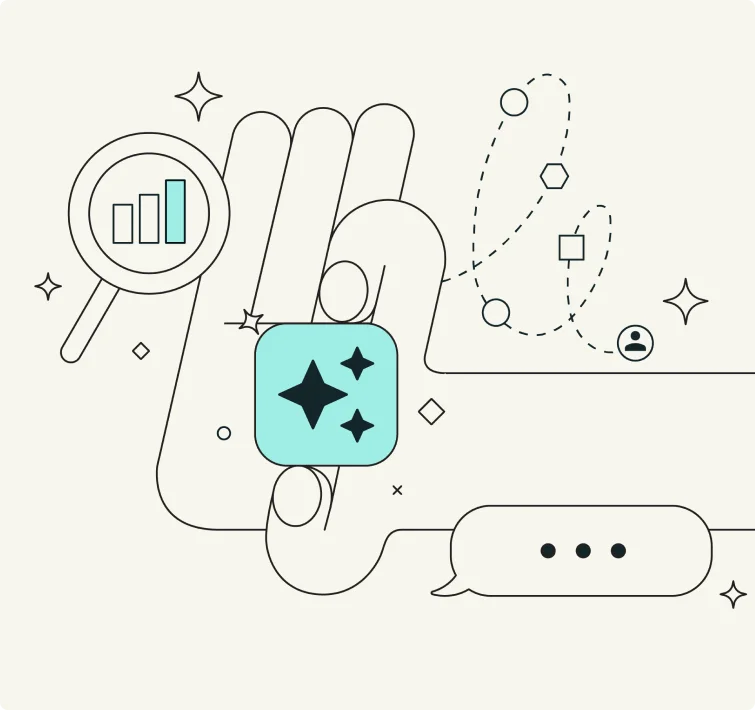Introducing Q: The AI Powering Autonomous Advertising at Quantcast

Written By
Kaitlin Forbes

Forget everything you've heard about AI being the "future" of advertising. For 81% of digital marketers¹, it's already here, driving real results like increased brand awareness and sales. At Quantcast, our AI drives better performance and finds you your next customer.
It's why we built Q, our powerful AI and machine learning engine that's been working tirelessly behind the scenes for nearly two decades! Q makes billions of intelligent decisions every second, such as optimizing bids, refining targeting, and driving better return on investment for advertisers globally.
Why Q Matters for Performance Marketers
Today’s performance marketers are under relentless pressure: prove ROI faster, do more with fewer resources, and master an increasingly fragmented ecosystem. Q was built to solve exactly these challenges by turning complexity into clarity and making campaigns not only perform better, but autonomously.
Unlike other DSPs, Quantcast brings two decades of real-world advertising learnings and a unique data foundation into play. At the core is our Audience Graph, which connects and interprets massive, real-time data sets from:
- Quantcast Measure: open-web signals and real-time audience insights from 100 million web destinations.
- Content Intelligence: maps billions of unique web pages - continually refreshed to maintain accuracy and provides a deep understanding of consumer interests and context.
- Households and Devices: comprehensive modeling connecting billions of devices and households, giving a view of consumer journeys across screens.
Q is the intelligence layer acting as the window into the Audience Graph that transforms these signals into action.
Behind the Scenes to Center Stage
Until now, Q has been the silent powerhouse, driving results in the background. Moving forward, it will become more visible and more accessible inside the Quantcast Platform. Marketers can now interact with Q directly to save time and deliver instant clarity:
- Agent Q – Get instant answers, live tag checks, and performance overviews in seconds. Automate tasks, resolve issues quickly, and get proactive insights to optimize campaigns with ease.
“It's really easy to type in …it'll pop up a report without needing to do too much.” - Medik Limited.
- Audience by Q – Take the complexity out of audience creation. Skip the manual filters and settings—our AI pinpoints your ideal audience with data-driven accuracy, driving up to 50% more conversions by reaching the right people and eliminating wasted spending.
"By leveraging their innovative technology, we've unlocked previously untapped environments, resulting in increased booking volumes and improved return on investment." - Accor Hotels.
- Creative by Q – Effortless creative optimization. Get an instant, objective grade and summary of your creative across five key categories, complete with concise, actionable recommendations to boost ad performance.
"[Quantcast] empowered us to act fast, optimise continuously, and ultimately deliver a high-performing campaign that reignited brand relevance." - Puma.
- Analysis by Q – The 'why' behind the 'win'. Get comprehensive campaign insights detailing key performance trends, mid and post-campaign, empowering smarter decisions that boost campaign health and results.
"I know the campaigns are doing this in the background, but actually seeing it summarized reinforces that." - DFS.
The result? Campaigns that are faster to set up, easier to manage, and optimized for maximum performance without adding more complexity to your day.
Real Results from Real Brands
The combination of Q’s AI-powered optimization and the Audience Graph is already transforming outcomes for advertisers:
- Vodafone saw a 25% increase in sales conversions, with 40% of sales driven by advanced audience targeting.
- MBNA/TD Bank beat campaign goals by 88% and increased approval rates by 38%.
- The Palace Company achieved 6x ROAS through a full-funnel strategy.
These results aren’t one-offs—they happen when performance marketing is fueled by real-time audience intelligence and applying two decades of AI expertise.
The Future is Autonomous AI
With Q, Quantcast isn’t just another DSP. We deliver autonomous AI-driven advertising—a faster, more measurable way to drive growth.
Share article
Ready to see what Q can do for your campaigns?

